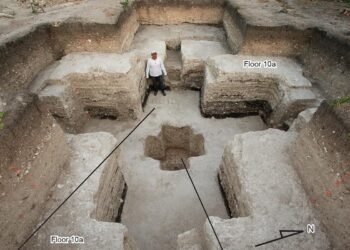Archaeologists have unearthed a fascinating cache of 15 human skulls at Masseria Candelaro, a Neolithic village in Puglia, Italy. The discovery, detailed in the European Journal of Archaeology, provides a unique glimpse into the ritualistic and symbolic significance of human remains in Stone Age societies.

The skulls, mostly belonging to males, were found in a pile within a sunken structure referred to as “Structure Q,” which was not a designated cemetery. Instead, this structure contained alternating layers of domestic and ritual artifacts, suggesting its use as a multifunctional space later repurposed for ceremonial activities. Radiocarbon dating of the fragments places their origin between 5618 and 5335 BCE, indicating they were collected and used over a span of nearly three centuries, potentially involving six to eight generations.
The fragments showed no signs of cut marks, violence, or healed trauma, ruling out the possibility of the skulls being war trophies or victims of violent death. Instead, the way the bones were broken suggests they were retrieved from burial sites and actively handled as part of an enduring ancestor ritual. Bioarchaeologist Michael Thompson, the study’s lead author, said: “Human bone had a specific kind of meaning, and perhaps was understood to be an efficacious or potent substance, given the regularity with which it was interacted with.”
The researchers propose that these skulls were part of rituals aimed at venerating specific ancestors rather than being used in standard funerary rites. Ancestors in many ancient cultures were considered to possess spiritual powers and serve as moral anchors for their communities. At Masseria Candelaro, the skulls likely represented a form of “working ancestors,” actively circulated and manipulated in ways that emphasized their contextual significance rather than their physical preservation.

While the final placement of the skulls in Structure Q might seem ceremonial, the researchers concluded that it was more likely a “post-use-life decommissioning” of these potent objects. In other words, once the skulls’ ritual purpose had been fulfilled, they were symbolically retired by being lightly covered with soil and left in a heap.
This discovery adds a new dimension to our understanding of Neolithic funerary practices and the complex ways in which ancient societies interacted with their dead. By combining bioarchaeological, taphonomic, and isotopic analyses, the study not only highlights a unique case of cranial curation but also expands the documented variations of ritual behavior in European prehistory. As the researchers stated, “The cranial cache represents a collection that was constantly changing, but its long duration suggests an enduring tradition of use, alteration, and augmentation.”
The findings also challenge simplistic interpretations of gender and power dynamics in Neolithic southern Italy. While the cache primarily consisted of male skulls, the researchers caution against assuming a male-dominated society. Instead, they suggest that the practice might reflect specific kinship or ritual identities tied to a heterarchical system with diverse connections to age and gender.
As Thompson and colleagues wrote, “What ‘ancestors’ meant varied widely, and at Candelaro, it signified a dynamic process of interaction and transformation, not static reverence.”























